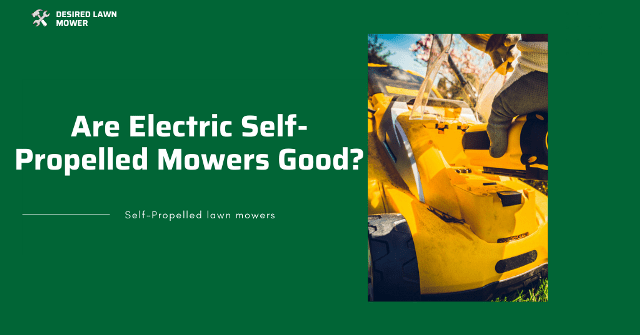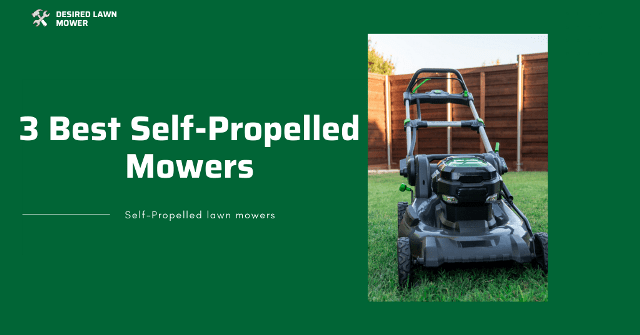Are Self-Propelled Mowers Worth The Money?
There are a gazillion methods of mowing a lawn on a spectrum of most to least favorite, and in most cases – if not even all the cases – the lawn owner sets the scope for which method fits which spot on the spectrum. This is because lawn features vary, so also the necessities of different lawn owners or landscapers. To paint a clearer picture, a person with a push mower could devour a football field wiping their foreheads with a grin until they have to walk the plains of a crazily-waved golf course with the same mechanism -suddenly egos and strengths are being pricked and questioned.
Table of Contents
What Exactly Propels a Walk-Behind Mower?
A transmission system; the self-propelled mower only moves by itself thanks to the automatic transmission system it is equipped with. This system serves as a bridge that connects power from the engine to the drive wheels of a machine converting engine torque to mechanical force, thus propelling the wheels of the machine.
Though of course, other factors complement the transmission to influence motion like the transaxle, pulleys, drive belts, and the power source of the machine. The motion is then triggered by squeezing on ‘the dead man’s lever’ – an eerie slang for the bail lever – continuously before you can mow, and releasing to abruptly halt the machine. The bail lever also operates as an immediate critical safety response in preference to fiddling around for a switch should you perceive an accident.
You Can Classify Self-Propelled Mowers Based on The Drive Wheels

Every lawn or scape comes peppered with different features requiring different kinds of mowers to make it easy for customization. Self-propelled mowers can be categorized based on the movement of their wheels and I’ll explain further to help you understand which mower is best for you.
- Front-Wheeled Self-Propelled Mowers
In this scenario, the front wheels are the dependent moving force of the machine. In simpler terms, they are the only wheels that move the mower forward.
This category is highly beneficial if your plan is flat and has a lot of obstacles like trees and flower beds that would require extra maneuvering.
The front-wheelers are easier to move around and a lot lighter compared to their counterparts. They make a neat 180-degree turn mostly by pushing down on the grip bar to raise the front wheels while you pivot.
Also, there are zero-turn self-propelled models for twirling on a spot offering a far, far better mowing experience; you wouldn’t need to make awkward turns at the ends of the stripe when you mow, but they definitely will cost you the extra bucks.
- Back-Wheeled Self-Propelled Mowers
Back-wheelers are the opposite of front-wheelers. They are much heavier and tougher in comparison. They are more expensive too. This is because they use stronger engines to power the rear wheels that happen to carry the most weight of the machine.
The back-wheelers are particularly engineered for uneven terrains that drop and surge in angles significant enough to be cautious of. They offer a much more satisfying balance for treading on tough hills and ridges.
The only point of consideration with this category when put to use is the weight. To move the mower around, you will have to lift it enough to make a nice turn, and that wouldn’t be fun to do if you’re not seeking every possible way to build muscles. Otherwise, they make good hiking companions.
- All-Wheeled Self-Propelled Mower
As the name implies, all the wheels of the mower rotate collectively to induce motion. To estimate the effectiveness of the all-wheel drive, simply combine the front and rear-wheelers and you have your measure. They are the best soldiers for bumps and hills and carry a great amount of power to ace you through without any problems! I strongly suggest the all-wheel-drive for wavy terrains.
Are Electric Self-Propelled Mowers a Good Choice?

The electric self-propelled mowers are straightforward to understand. They require a battery and a charging system to function and are significant for enabling a noiseless, clean and smokeless environment whilst mowing. There are two types of electric mowers: cordless and corded mowers– I’ll explain.
- Cordless Electric Self-Propelled Mowers
This type operates on a rechargeable battery system. The power is measured in volts and would vary depending on the model or brand of the mower– say 16 – 30 volts. All you have to do is recharge your mower, and run around the yard with it till it runs out of power. It’s just as identical as using any rechargeable device you know. The only downside with this machine is they don’t run that long, so you get 40 minutes – 1 hour max on the cordless mower. I do not recommend this machine if your yard is more than 1 acre. Honestly, half an acre is the best measure you can bet on.
- Corded Electric Self-Propelled Mowers
The corded mowers are the opposites of cordless mowers. Here you have a lengthy power cord connected to a power socket to start up the machine. So in other words, you have an unlimited power supply as long as the cord is connected. As rosy as this may sound, there are ways the scene could go wrong: the cord could get tangled in obstacles or get under the deck to be torn to shreds right away, and movement will be highly limited to the length of the cord or the distance of the power socket. Unless you carry it along with an extension box, which would in turn only put more cables on the yard. The only upside with this mower is they are very affordable. That being said, I only recommend this model if you have about a quarter of an acre with an unobstructed power supply.
Are The Gas-Powered Self-Propelled Mowers a Better Option?

The gas-powered self-propelled mowers function on petroleum like many other machines. Unlike the electric mowers, you get the freedom to move around as you like without having to bother about charging ports or dreadful cords. The gas mowers have different sizes of fuel tanks to match their capabilities. You have a range of a quarter to 2 gallons of tank space and can mow half to 1 acre per tank depending on the volume and the workload.
The major downsides of gas-powered mowers are the noise and pollution they come with. They are loud enough for you to need earmuffs and release a great deal of smoke. Added to this, you have the common plague of maintenance and repairs. Although, in comparison to the electric models, the gas-powered ones are much more reliable and effective for mowing both big and small vacua of grass. They are a much better option in terms of dependability and heavy-duty.
Self-Propelled Mowers Have Deck Size Options For Every Lawn
Just like every other lawnmower, it simply isn’t properly classified or customized without putting into consideration the deck size. Self-propelled mower decks range from 18 to 36 inches in width and can either be equipped with single or dual blades. If your lawn is on the small side, there isn’t a need to go for larger deck sizes that would cost you more expenses and storage space. The regular-sized half an acre yard will appreciate an 18 – 22 inch deck size and a much wider lawn of more than an acre will do better with the 22 – 36 inch deck.
Self-Propelled Mowers Offer The Extra Beneficial Functions You Need
Not only restricted to mowing, but self-propelled mowers will also bag, mulch, and side discharge the clippings in the neatest way possible. Also, because they’re handy and maneuverable, the task is more effective and satisfying since you get a closer grip on achieving your taste without the horrendous manual labor. So if you’d rather have other functions for your ideal walk-behind mower to achieve, you can bet on a self-propelled mower to kill two birds with a stone.
Is a Self-Propelled Mower Worth It?
Self-propelled mowers are worth every dime they get. They are compact, simpler to understand, easier to maintain, much more lenient to master, and more affordable in comparison to riding mowers. Added to these points, you’d finally be doing away with the manual labor that comes with the push mowers!
Three Best of The Best Self-Propelled Mowers For Your Necessities

If you’ve gone through all the comparisons and elaborations, you will need to place your bet or interest in the best self propelled lawn mowers to properly relieve your concerns whilst mowing. Well, here they are:
- Worx 17-inch Self-Propelled Mower
Worx mower offers exceptionally good quality features such as the ability to increase torque for denser grasses, and efficient battery power that would yield up to 80v, with mulching and bagging options. They are extremely low-maintenance, environment friendly, and would save you the ear-splitting noise that is accustomed to lawnmowers– I highly recommend this mower if a compact machine with efficient power is what you’re looking for.
- LawnMaster 17-inch Self-Propelled Mower
LawnMaster features an aggressive rust-resistant deck of 17 inches with 5 cutting heights. They’re built for equally tough grasses that would need the extra bounce to put them down more effectively. They roll on a 48v brushless motor that delivers a speed of 3100amp, so you can maximize your money’s worth. To top it all, they are foldable and compact in structure weighing only 29.76 pounds to help movement easier. I wouldn’t slack on the LawnMaster if my yard needs the extra power to put it in shape. I highly recommend it.
- The Ego Power 21-inch Self-Propelled Mower
This battery-powered brand of mowers will have you grateful for your faith in electric mowers. They are silent and quite powerful offering you a very satisfying trek around the lawn. For one charge session, you are equipped with enough power to run you for an hour on your small or medium-sized lawn. They come with an easy push-button start and fancy led lights for mowing early or late hours much easier. In a debate about which electric mowers offer the best service, I would strongly propose the Ego Power with no qualms.
The Summary You’ve Been Seeking
You can assemble the most fitting mower for you and your lawn based on the different but fundamental features they possess for a personal heightened experience. There are many brand and model options to help you transform your chore into a hobby in no time. Conclusively, self-propelled mowers are the best choice for smaller or medium-sized lawns because of their features. If your yard is larger than 1½ acres with the toughest kinds of grass to ever be green, you might have them a little problematic to effectively mow. Other than that, you’re good to go!







